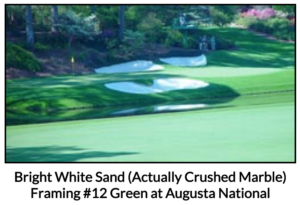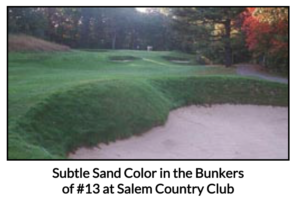Bunker Sand
A few years ago I was invited to play a golf course in Maine named Belgrade Lakes. Located about 12 miles due north of Augusta, a bit off the beaten path, Belgrade Lakes is a lovely course.
I found the layout, designed by Scotsman Clive Clark (he also did Lake Winnipesaukee Country Club), to be an enjoyable play through rolling terrain. Beautifully conditioned greens, tees and fairways but, from the very first hole, the most striking feature of the course was the bunker sand.
A very dark brown coloration, course texture and a look of firmness; if you play Belgrade Lakes, I you’ll immediately see the uniqueness of the sand in the bunkers.
As we played along that day I started to think just how much the sand in a golf course’s bunkers affects its aesthetics, as well as its playability. At first thought it might seem insignificant, but the color and the texture of the sand in the bunkers has a major impact on a golfer’s experience from a round of golf.
On courses with bright white bunker sand it’s the sand itself that plays a very prominent part in defining a hole…on courses with darker more subtle colored sand in its bunkers; it’s the bunker shape and
mowing practice that are more the element of a hole’s definition.
 At the Augusta National Golf Club, home course to the renowned Masters Tournament, the Alister MacKenzie steep face bunkers have sand that is gleaming white in color. The bunker sand at Augusta is a very prominent component in the framing of each hole which any golf fan knows from watching each year’s telecast of golf’s first major championship.
At the Augusta National Golf Club, home course to the renowned Masters Tournament, the Alister MacKenzie steep face bunkers have sand that is gleaming white in color. The bunker sand at Augusta is a very prominent component in the framing of each hole which any golf fan knows from watching each year’s telecast of golf’s first major championship.
As a contrast, the sand in the Donald Ross sod face bunkers at Salem (Massachusetts) Country Club is of a darker color making the sand more subtle in its appearance. At Salem, as well as other courses with sod face bunkers, it’s the shape of the bunkers, not the sand, which helps provide the definition of each hole.
And, in addition to definition, the playability of each course is greatly impacted by the sand in its bunkers. Soft textured bunker sand will allow a ball to more deeply penetrate the surface creating a lie that is down (sometimes even buried)… on courses with firm textured bunker sand the ball will usually sit up.
Quite simply: it’s much easier to play from a propped up lie in a firm bunker than to play an explosion shot from a buried lie in soft sand. In fact, one reason the pros are so proficient from the bunkers is that bunkers are usually filled with firm sand…another reason is that they are really good!
As I researched this topic I was quite surprised to learn that the gleaming white sand, like that in the bunkers at Augusta National, is actually crushed marble! And, I was further surprised to learn how technical the analysis of bunker sand can become. Read the following excerpt taken from a research paper put out by Turf Diagnostics and Design, Inc.
“The bunker sand evaluation process involves three distinct parts. The penetrometer test, color, shape, crusting, and set-up make up the bunker evaluation phase. The particle size and infiltration rate analyses are determined using standard operating procedures from the Methods of Soil Analysis (American Society of Agronomy) and the American Society for Testing and Materials (ASTM). The sand size distribution is based on the United States Department of Agriculture (USDA) definition of sand grain classification. The bunker evaluation test series is conducted using the procedures published in Golf Course Management (1986, 54:64-70).”
Wow! That’s some very technical stuff all aimed at determining the best appearing, and most playable sand for the bunkers of any given course. That said, the color and texture of the sand in most golf courses’ bunkers however, is seldom chosen by such a technical scientific analysis. Because of processing and transportation costs the majority of the world’s golf courses have bunkers that are filled with sand from local pits.
Here in New England we are very fortunate to have several pits that yield good sand for bunkers. For many years it was Nardone in Westford, Massachusetts which provided high quality sand for course bunkers throughout the area. The sand from Nardone, a pleasant lighter tone color, was always low in “fines” allowing for good drainage; Nardone sand also had good particle size which packed into a nice firmness. Interestingly, when the bunkers were redone for the 2004 US Women’s Open at The Orchards in South Hadley, MA, the USGA selected sand from Nardone.
Unfortunately, the famous Nardone pits have been emptied of all the quality material. But, new sources are being found. More recently it has been Fosters in Henniker, NH where the good bunker sand is being mined. And, most industry experts report that the sand from Fosters is every bit the equal to that which came from the famed Nardone pits.
There you have it…bunker sand. It has a dramatic impact on the aesthetics and playability of every golf course. I don’t know where Belgrade Lakes sourced its bunker sand; but I played that entire round without hitting my ball in one bunker and…my one lasting impression of the course is that brown bunker sand!
| Prologue: Regardless of the type of sand used at any course, bunkers require constant maintenance. Raking, edging on virtually a daily basis is only the beginning. Each spring almost every bunker on New England golf courses requires major rehabilitation. And, after every heavy rain storm it’s inevitable that washouts develop in the sand – to restore playability these washouts must be repaired.
The original bunker sand at The Oaks was sourced from Foster’s pits. And, all additional sand at The Oaks and Candia Woods comes from Fosters.
|
 |
| Bunkers are integral and unique at each course you play… enjoy the nuances of the bunker sand. And please, rake disturbed areas after playing shots from the sand!
|






